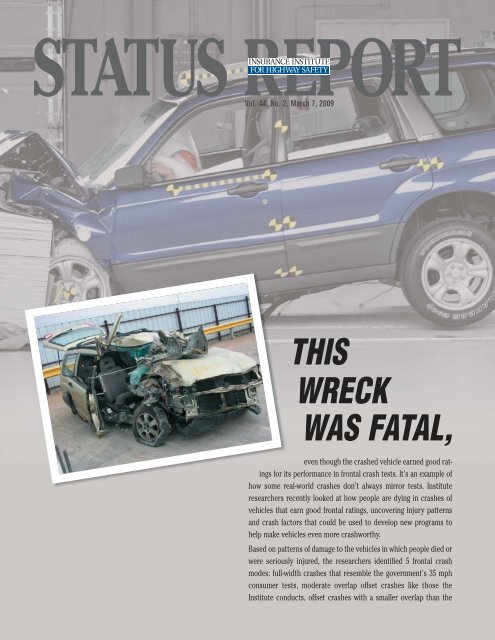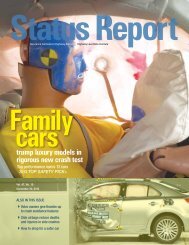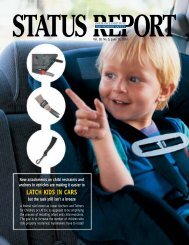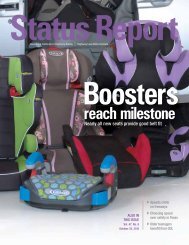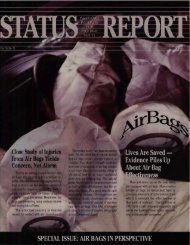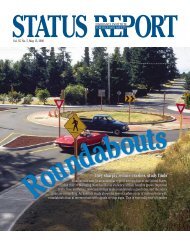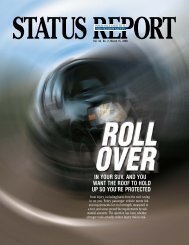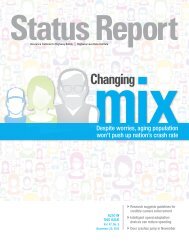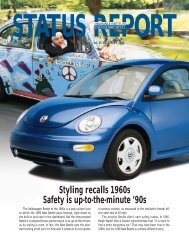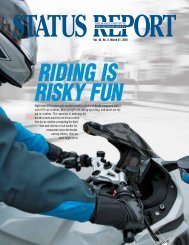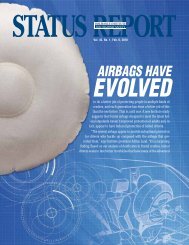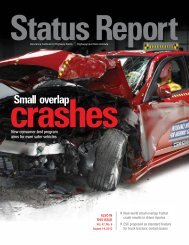Status Report, Vol. 44, No. 2, March 7, 2009 - Insurance Institute for ...
Status Report, Vol. 44, No. 2, March 7, 2009 - Insurance Institute for ...
Status Report, Vol. 44, No. 2, March 7, 2009 - Insurance Institute for ...
- No tags were found...
You also want an ePaper? Increase the reach of your titles
YUMPU automatically turns print PDFs into web optimized ePapers that Google loves.
<strong>Vol</strong>. <strong>44</strong>, <strong>No</strong>. 2, <strong>March</strong> 7, <strong>2009</strong>THISWRECKWAS FATAL,even though the crashed vehicle earned good ratings<strong>for</strong> its per<strong>for</strong>mance in frontal crash tests. It’s an example ofhow some real-world crashes don’t always mirror tests. <strong>Institute</strong>researchers recently looked at how people are dying in crashes ofvehicles that earn good frontal ratings, uncovering injury patternsand crash factors that could be used to develop new programs tohelp make vehicles even more crashworthy.Based on patterns of damage to the vehicles in which people died orwere seriously injured, the researchers identified 5 frontal crashmodes: full-width crashes that resemble the government’s 35 mphconsumer tests, moderate overlap offset crashes like those the<strong>Institute</strong> conducts, offset crashes with a smaller overlap than the
FULL-WIDTHcrashes are usually head-on.In this one, a 2001 Acura TLcollided with an oncoming1996 Oldsmobile Delta 88that crossed into its lane.The Acura driver sustainedleg and chest injuries.MODERATE OVERLAPSare offset crashes thatinvolve about 40 percent ofa vehicle’s front end. Thedriver of this 2005 ToyotaCorolla was traveling onthe wrong side of the roadand struck a MercedesS320. The driver of theCorolla died of chestand abdominal injuriessustained in the impact.SMALL OVERLAPSare offset crashes involvingabout 20 percent or less of avehicle’s front. This 2001Ford Taurus was hit by a1994 Chevrolet Capricegoing the other way. TheChevy driver lost control,skidding on the wet road.Both drivers died.CENTER IMPACTSmost often occur whenvehicles run off the road andhit narrow objects like utilitypoles. The 78-year-old driverof this 2004 Lexus ES 330drove off the right side ofthe road and hit a tree atabout 40 mph. She sufferedchest injuries and died.UNDERRIDE CRASHESoccur when a vehicle goespartially or wholly under abigger one, usually a largetruck, SUV, or pickup. Thedriver of this 2001 ChevroletImpala was hit from behindand then crashed into aparked tractor-trailer. Hishead injuries were fatal.FRONTAL CRASH CASESIN CARS RATED GOOD<strong>Institute</strong>’s test, center impacts into narrow objects like poles,and underride crashes with medium and heavy trucks, SUVs,and pickups. To understand what problems a new test programshould address, the researchers also sorted the frontal crashesaccording to whether the injuries appeared related more tointrusion, restraint factors, or occupant factors.“We mark the success of our 14-year-old frontal test programby the vehicles that earn good overall ratings and thelives saved by improved designs,” says <strong>Institute</strong> presidentAdrian Lund. “Still thousands of people die each year in frontalcrashes. The continued presence of more than 14,000 suchfatalities — 13,374 to front-seat occupants in 2007 — compelsus to focus on these deaths and new crash test programs thatcould encourage vehicle designs to help prevent them.”Researchers analyzed 2000-06 case files from the NationalAutomotive Sampling System/Crashworthiness Data System onfrontal crashes in which 116 drivers and right front passengerswere seriously injured or killed despite using safety belts. Thevehicles had to have good frontal crashworthiness ratings inthe <strong>Institute</strong>’s offset test, and all but 1 earned 4 or 5 star ratingsout of the maximum 5 in the federal government’s 35 mph fullwidthNew Car Assessment Program (NCAP) test.“We found that a lot of frontal crashes are happening in configurationsthat aren’t represented in the crash tests being conductedright now, either by us or the National Highway TrafficSafety Administration,” says David Zuby, <strong>Institute</strong> senior vicepresident <strong>for</strong> vehicle research and an author of the study.“Automakers design vehicles to per<strong>for</strong>m well in these tests, sowe wanted to explore if other kinds of frontal tests couldaddress the life-threatening injuries that occur in the field.”Some of the crashes in the study were so extreme that thedeaths and injuries probably can’t be addressed in crash tests.Some involved very high speeds or unusual conditions. In onefatal case a car went off an open drawbridge.One of the biggest crash groups in the study involved peoplekilled or injured in vehicles whose safety cages collapseddespite good test ratings. Intrusion was an obvious factor.In other cases, the vehicles’ safety cages did a good job ofmanaging crash <strong>for</strong>ces, but people died because factors suchas their age, health, weight, or stature increased their vulnerability.Or the restraints weren’t ideally suited <strong>for</strong> the occupantsand the crashes, either allowing an occupant to hit somethinginside a vehicle or holding an occupant tightly enough tocause injury.Center impacts: Nineteen percent of crashes in the studywere center impacts into trees, poles, or posts. In all but 2 ofthese cases the vehicle structure prevented substantial intrusion.Almost half of the vehicles hit something else be<strong>for</strong>e runningoff the road and striking a narrow object. Researchersidentified 10 of the center crashes as having restraint factorsthat contributed to occupant injuries and 7 as having occupant
<strong>Status</strong> <strong>Report</strong>, <strong>Vol</strong>. <strong>44</strong>, <strong>No</strong>. 2, <strong>March</strong> 7, <strong>2009</strong> 3factors or both restraint and occupantfactors.Neither the <strong>Institute</strong> nor the governmentincludes frontal pole tests intheir consumer in<strong>for</strong>mation programs.For research purposes, the <strong>Institute</strong>has conducted some frontal tests intoa 10-inch diameter pole using vehiclesrated good, but the injury risk concernsthese tests raised didn’t seem tomatch the chest and abdominal injuriesreal people sustain in similarcrash modes.The dummies used in frontal crashtests and the chest injury criteria mayneed to be revised to better reflectinjury risks, Zuby says. This work alsohas prompted the <strong>Institute</strong> to considerhow the position of occupants andthe per<strong>for</strong>mance of their restraints areinfluenced by off-road excursions liketree impacts.Full-width crashes: Only 6 percentof the occupants were in full-widthimpacts like those simulated in NCAPtests. <strong>No</strong>ne of the occupants died, andthe vehicles had little or no intrusion.“Based on this sample of cases, relativelyfew restrained occupants seriouslyinjured in frontal crashes are inimpacts resembling the NCAP test setup,”Zuby says. “This likely wouldn’thave been the case 20 or 30 years ago,back in the early days of the testingprogram be<strong>for</strong>e safety became a salesstrategy. Because most vehicles nowearn top marks <strong>for</strong> frontal crashworthinessin NCAP tests, it’s clear thisprogram has done a good job of influencingdesigns that protect people inhead-on full-width crashes, and thereal-world crashes we studied bearthis out.”Moderate overlaps: The configurationof the <strong>Institute</strong>’s offset test is amoderate, 40 percent overlap of thedriver’s side of the vehicle. This typeof crash accounted <strong>for</strong> 24 percent ofthe cases studied.About half of the belted peopleseriously injured in moderate overlapcrashes were in vehicles that otherwiseheld up pretty well, so other factorsbesides vehicle structure cameinto play.In the other half of the moderateoverlap crashes studied, the vehicles’safety cages allowed substantial intrusioninto the occupant compartments,which likely contributed to injuries.These intrusion crashes also occurredat much higher speeds than the <strong>Institute</strong>’stest, so the conditions weremore severe.“Manufacturers design cars, minivans,SUVs, and pickups to do well inour offset test,” Zuby says. “But thesereal-world crashes with intrusionshow that <strong>for</strong> some vehicles, at least,occupant protection drops off asfrontal impacts become more severe.”This suggests that the <strong>Institute</strong>’soffset test “may not be driving thekinds of improvements in vehiclestructures and restraint systems thatare needed to protect people in higherseverity crashes. We might need toconsider conducting additional tests,”Zuby points out. He adds, “One concern,though, is that the kinds of restraintsystem and structural changesthat more severe offsets would necessitatecould be counterproductive inother kinds of crashes.”Small overlaps: Another 24 percentof the study cases were small overlaps.That is, they didn’t involve very muchof the vehicles’ front ends. These weremost common among crashes in whichintrusion contributed to injuries. Fortythreepercent of crashes with a lot ofintrusion were small overlaps involvingaround 20 percent or less of the vehicles’front ends. The <strong>Institute</strong>’s currentoffset test isn’t intended to evaluatecrashworthiness in such cases.Few vehicles have energy-absorbingstructures that extend to the edges ofthe front end, and this may be why somany small overlap crashes involvedintrusion into the occupant space. Instead,more metal (continues on p.6)2010OCCUPANT INJURY FACTORSBY CRASH CONFIGURATIONSfullwidthmoderateoverlapsmalloverlapINJURY FACTORSoccupant factorrestraint factorintrusionoccupant/restraintcenterunderrideMANY FRONTAL CRASHESOCCUR IN CONFIGURATIONSTHAT AREN’T REPRESENTEDIN CRASH TESTS CONDUCTEDBY EITHER THE INSTITUTE ORTHE FEDERAL GOVERNMENT.AUTOMAKERS DESIGN VEHICLESFOR GOOD PERFORMANCEIN THESE TESTS, SO THEREMAINING QUESTION IS,HOW CAN PASSENGERVEHICLE CRASHWORTHINESSBE IMPROVED TO REDUCETHE DEATHS AND INJURIESTHAT STILL OCCUR IN FRONTALCRASHES OF VEHICLES WITHGOOD RATINGS?
4 <strong>Status</strong> <strong>Report</strong>, <strong>Vol</strong>. <strong>44</strong>, <strong>No</strong>. 2, <strong>March</strong> 7, <strong>2009</strong>VOLUNTARY RULES ON VEHICLECOMPATIBILITY SUCCEEDAS RESEARCH WINDS DOWNLocked in a competitive business, automakers occasionally pauseand cooperate to improve vehicle safety. A recent example involvesthe compatibility of smaller and larger passenger vehicles when theycollide. Fifteen automakers got together and agreed on the first set ofrules ever devised to reduce the risks to people in cars that are struckin the front and side by larger and heavier SUVs and pickup trucks.“The automakers researched this issue, identified ways to reducethe risk, and agreed to appropriate measures — and they did all thisfaster than the government could have through regulation,” says<strong>Institute</strong> senior vice president Joe <strong>No</strong>lan. “This doesn’t mean collidingpassenger vehicles now are compatible in every crash, but itdoes mean car occupants are less likely to be injured or killed whenthey collide with SUVs and pickup trucks.”The impetus to launch this work in 2003 was a growing concernabout the changing mix of passenger vehicles on US roads. SUVs wereproliferating and this, in turn, was exacerbating the risk to occupantsof cars with which the larger passenger vehicles were colliding.Such risks are quantifiable, and they’re substantial. For example,during 2000-03 SUVs caused about 50 percent more deaths in carswith which they collided than did cars of comparable weight whenthey collided with other cars (see <strong>Status</strong> <strong>Report</strong>, April 26, 2003; on theweb at iihs.org).“Some SUV and pickup characteristics, beyond just their weightcompared with cars, increase the risk in colliding cars,” <strong>No</strong>lan explains.“Identifying and addressing these characteristics was the goalof the automakers’ working groups on front and side compatibility.”Initial accomplishments: The working group addressing frontalcrashes agreed to design the front ends of SUVs and pickups so theirenergy-absorbing structures would line up better with those on cars(see <strong>Status</strong> <strong>Report</strong>, April 28, 2005; on the web at iihs.org). This would reducethe likelihood that a pickup or SUV would override a colliding carand, in turn, enhance the ability of colliding vehicles’ front ends to absorbcrash energy, keeping it away from both occupant compartments.Initial proof of this improvement came from <strong>Institute</strong> analyses offatality risk in cars colliding with SUVs that did and didn’t initiallycomply with the new geometric criteria (see <strong>Status</strong> <strong>Report</strong>, Jan. 28,2006; on the web at iihs.org). The death rate of belted car drivers infrontal crashes with 2000-03 model SUVs during 2000-04 was 18 to 21percent lower when the SUVs already met the criteria than whenthey didn’t. The corresponding risk reduction in crashes with complyingpickup trucks was 9 to 19 percent.To improve protection in cars struck in the side, the automakersinitially agreed to improve head protection — critical because theride height of SUVs and pickups increases the risk of striking caroccupants’ heads. Auto manufacturers are complying with thisagreement by installing head-protecting side airbags.About 50 percent of 2003 passenger vehicles had standardor optional side airbags, and now the proportion tops 85 percent.<strong>Institute</strong> research indicates that such airbags are reducingfatality risk by about 37 percent among car drivers struckon their side of the vehicle (updated from <strong>Status</strong> <strong>Report</strong>, Aug.26, 2003; on the web at iihs.org).Automakers agreed that all of their pickups and SUVs builtafter August <strong>2009</strong> will meet the voluntary agreements toimprove compatibility in front and side crashes. Eighty-onepercent of the 2007 models that were sold complied with thefrontal compatibility agreements, and 71 percent compliedwith the agreements addressing side impacts.Model was side airbag group: The compatibility workinggroups weren’t the automakers’ first such ef<strong>for</strong>ts. In 1999the National Highway Traffic Safety Administration (NHTSA)asked the industry to develop test procedures to assess therisk of occupant injury from inflating side airbags. The benefitsof frontal airbags had been marred by deaths and injuriescaused by deployments (see <strong>Status</strong> <strong>Report</strong>, Feb. 3, 1996; on theweb at iihs.org), and the goal was to avoid a similar problem
with side airbags. The automakers responded by organizing a workinggroup and asking Adrian Lund, then a senior vice president at the<strong>Institute</strong>, to lead it.NHTSA monitored this group, which standardized test proceduresto ensure that inflating side airbags wouldn’t harm occupants, especiallyout-of-position children. Participating automakers submittedthe procedures to NHTSA only 15 months after they started the project(see <strong>Status</strong> <strong>Report</strong>, Sept. 13, 2004; on the web at iihs.org). NHTSAadopted the procedures and began identifying passenger vehiclesthat already complied. The agency made this in<strong>for</strong>mation availableto consumers on its website and in its publications.“This ef<strong>for</strong>t led directly to the compatibility working groups,”Lund points out. “NHTSA asked automakers to address compatibilitythe same way because the side airbag ef<strong>for</strong>t had been so successful.But then agency officials kept their distance from the compatibilityworking groups. It’s un<strong>for</strong>tunate because the automakers didsome important work, and NHTSA’s hands-off approach could discouragethem from convening such groups in the future.”Unfinished work on compatibility among passenger vehicles:Besides adopting geometric design criteria to address incompatibilityamong vehicles in frontal crashes, automakers agreed to acceleratetheir research toward further compatibility improvements. Thegoal was to make the stiffness of passengervehicles’ front ends, not just their geometry,more compatible. Toward this the working groupper<strong>for</strong>med a series of barrier tests, vehicle-to-vehicle crashtests, and computer simulations, looking <strong>for</strong> new ways to enhancecompatibility among vehicles and to evaluate such approaches.The results didn’t pan out. The auto manufacturers will report toNHTSA that they “could not demonstrate that such alternative measuresof vehicle frontal collision compatibility would yield real-worldsafety benefits equivalent or superior to those” they already hadachieved by enhancing the geometric line-ups of the front ends ofpassenger vehicles.Lund agrees that “this kind of basic research is difficult to run bycommittee, but automakers might have done more research andaccomplished more than they did on compatibility if NHTSA hadshown more interest.”The <strong>Institute</strong> along with the Alliance of Automobile Manufacturersand Association of International Automobile Manufacturersled the compatibility working groups. Participating automakers includedBMW, Chrysler, Ford, General Motors, Honda, Hyundai, Isuzu,Kia, Mazda, Mercedes, Mitsubishi, Nissan, Subaru, Suzuki, Toyota,and <strong>Vol</strong>kswagen.
6 <strong>Status</strong> <strong>Report</strong>, <strong>Vol</strong>. <strong>44</strong>, <strong>No</strong>. 2, <strong>March</strong> 7, <strong>2009</strong>NEW CRASH TESTSCOULD HELP SPURVEHICLE DESIGNSTHAT DO A BETTERJOB OF PROTECTINGPEOPLE IN SMALLOVERLAP CRASHESLIKE THESE — AND INSOME FULL-WIDTH ANDMODERATE OVERLAPCRASHES, TOO.(continued from p.3) is concentratedtoward the centers of vehicles, whichhelps limit intrusion in center impactswith things like trees, posts,and utility poles.“Based on results of this study,we think small overlap tests havegood potential to improve the crashworthinessof new vehicles,” Zubysays. “This would help spur vehicledesigns with beefed up structuralprotection across the full width ofthe front, including the outer corners.It also would result in betterprotection <strong>for</strong> some occupants inmoderate overlap and full-widthcrashes. We plan to conduct somesmall overlap crash tests to see if anevaluation program on a wider scaleis justified.”Crashes that involved underride:These are when passenger vehicles gopartially or all the way under a largervehicle such as a truck rig. After smalloverlap crashes, underrides accounted<strong>for</strong> the most impacts in whichintrusion was an injury factor.Eight of the underride crashesinvolved heavy-duty truck rigs ormedium trucks, and the other 6involved impacts with pickups orSUVs. Half of these 14 underride caseswere fatal.Underrides that involve SUVs andpickup trucks have been addressedto some extent by the voluntary workauto manufacturers are doing to alleviatethe incompatibility in crashesbetween these large passenger vehiclesand cars (see pp.4-5). Still theprevalence of truck underride crashessuggests a need <strong>for</strong> improvedguards on large trucks.This isn’t a new idea. In fact, a1997 <strong>Institute</strong> study estimated thatabout half of all fatal crashes betweenlarge trucks and cars involvedfront, side, or rear underride (see<strong>Status</strong> <strong>Report</strong>, Feb. 15, 1997; on theweb at iihs.org).For a copy of “Impact and injurypatterns in frontal crashes of vehicleswith good ratings <strong>for</strong> frontalcrash protection” by M.L. Brumbelowand D.S. Zuby, write: Publications,<strong>Insurance</strong> <strong>Institute</strong> <strong>for</strong>Highway Safety, 1005 <strong>No</strong>rth GlebeRoad, Arlington, Va. 22201; or emailpublications@iihs.org.FRONTAL AIRBAGSFAILED TO INFLATE,NEWSPAPER REPORTSThousands of people have survived crashes because oftheir frontal airbags, but an early problem involved inflationwhen the airbags should have stayed stowed away.Design changes addressed this (see <strong>Status</strong> <strong>Report</strong>, Aug.6, 2005; on the web at iihs.org), and now the issue iswhether people are being left unprotected in crashes becausetheir frontal airbags failed to inflate. New <strong>Institute</strong>analyses indicate a potential problem, but a limited one.The latest controversy began with an October 2007Kansas City Star report that at least 1,400 occupants diedduring 2001-06 in frontal crashes in which their airbagsdidn’t inflate. Based on data from the federal FatalityAnalysis <strong>Report</strong>ing System (FARS, a census of fatal crasheson US roads), the Star implied that more than 200 deathsper year are being caused by airbag system failures.Responding to the Star, <strong>Institute</strong> researchers have takena closer look at FARS data plus in<strong>for</strong>mation from a sampleof crashes in another federal database, the NationalAutomotive Sampling System/Crashworthiness Data System(NASS/CDS), finding that all but a few of the apparentairbag failures are either FARS errors or cases when airbaginflation wouldn’t have been expected.According to FARS, 18 percent of front-seat occupantdeaths in frontal crashes of 1994-2006 models during1998-2006 involved airbags that apparently failed todeploy. However, 54 of the nondeployment cases also areincluded in NASS/CDS, and in 25 of these cases NASS/CDSreports that the airbags actually did inflate.“FARS is useful, but the police who supply the datadon’t always note correctly whether an airbag deployed,”says Elisa Braver, the <strong>Institute</strong>’s senior epidemiologist.“This is why sometimes you have to dig deeper to seewhat actually happened in a given crash, and NASS/CDSis a good source <strong>for</strong> a deeper dig. The Star reporters simplyrelied too much on FARS.”The NASS/CDS sample includes more detailed in<strong>for</strong>mationon crashes than FARS. The in<strong>for</strong>mation is collectedby trained investigators instead of police officers whohave to juggle competing duties at crash scenes.To get a handle on the true extent of the airbag nondeploymentproblem, <strong>Institute</strong> researchers reviewed 628frontal crash deaths included in both FARS and NASS/CDS. The airbags inflated in 548 of these cases. Of theremaining 80 deaths, 26 occurred in vehicles so thoroughlydestroyed in fiery crashes that the NASS/CDS
investigators couldn’t determine whetheror not the airbags inflated. In another 11cases the airbags had been switched off orremoved from the vehicles.This leaves 43 potential airbag failures,which <strong>Institute</strong> researchers studied indetail. The airbags wouldn’t have beenexpected to inflate in 25 cases because, <strong>for</strong>example, the vehicles underrode trucks, bypassingthe airbag sensors, or they rolledover. Airbags inflate only when sensorsdetect a frontal crash.In 11 cases, the extent of damage to thefronts of the crashed vehicles indicates theairbags would have been expected toinflate. In 6 other cases the airbags possiblyshould have inflated (impact severity wasborderline). These deaths in the NASS/CDSsample translate into an estimated 50 to 100deaths per year involving potential airbagfailures. It’s 1 to 2 percent of all deaths offront-seat occupants in frontal crashes.“This isn’t as many deaths involvingpotential failures as the Star implied, andit’s possible that even these nondeploymentswere associated with crash complexitieswe couldn’t account <strong>for</strong>,” Braverexplains. “Still it’s hundreds of deaths duringthe years of our study, and we need tosee if they could have been avoided.”For a copy of “How often do frontal airbagsfail to deploy in fatal frontal crashes?”by E.R. Braver et al., write: Publications, <strong>Insurance</strong><strong>Institute</strong> <strong>for</strong> Highway Safety, 1005<strong>No</strong>rth Glebe Road, Arlington, VA 22201, oremail publications@iihs.org.THE FATALITY ANALYSISREPORTING SYSTEMCODES THESE AIRBAGSAS NOT HAVING INFLATEDIN CRASHES. BUT THEAIRBAGS OBVIOUSLY DIDINFLATE. MOST PROBLEMSARE ERRORS IN THEDATABASE, NOT AIRBAGSTHAT FAILED TO INFLATEWHEN THEY SHOULD HAVE.
NON-PROFIT ORG.U.S. POSTAGEPAIDPERMIT NO. 252ARLINGTON, VA1005 N. Glebe Rd., Arlington, VA 22201Phone 703/247-1500 Fax 247-1588Internet: www.iihs.org<strong>Vol</strong>. <strong>44</strong>, <strong>No</strong>. 2, <strong>March</strong> 7, <strong>2009</strong>Crashes in the real world don’t alwaysmirror tests, so new frontaltests merit exploration ...................1Frontal crash case files illustrate 5important configurations ...............2Having improved compatibility,automakers disband cooperativeef<strong>for</strong>t to address this issue .............4Frontal airbags reportedly failedto inflate, but <strong>Institute</strong> researchersfound errors in the way crash datasometimes are reported .................7Contents may be republished with attribution.This publication is printed on recycled paper.The <strong>Insurance</strong> <strong>Institute</strong> <strong>for</strong> Highway Safety is anonprofit scientific and educational organizationdedicated to reducing deaths, injuries, and propertydamage from crashes on the nation’s highways.The <strong>Institute</strong> is wholly supported by auto insurers:21st Century <strong>Insurance</strong>AAA Mid-Atlantic <strong>Insurance</strong> GroupAAA <strong>No</strong>rthern Cali<strong>for</strong>nia, Nevada, and UtahAffirmative <strong>Insurance</strong>Agency <strong>Insurance</strong> Company of MarylandAIG Agency AutoAlfa <strong>Insurance</strong>Alfa Alliance <strong>Insurance</strong> CorporationAllstate <strong>Insurance</strong> GroupAmerican Family Mutual <strong>Insurance</strong>American National Property and Casualty CompanyAmeriprise Auto & HomeAmerisure <strong>Insurance</strong>Amica Mutual <strong>Insurance</strong> CompanyAuto Club GroupAuto Club South <strong>Insurance</strong> CompanyBituminous <strong>Insurance</strong> CompaniesBristol West <strong>Insurance</strong> GroupBrotherhood Mutual <strong>Insurance</strong> CompanyCali<strong>for</strong>nia CasualtyCapital <strong>Insurance</strong> GroupChubb Group of <strong>Insurance</strong> CompaniesConcord Group <strong>Insurance</strong> CompaniesCotton States <strong>Insurance</strong>COUNTRY FinancialCountrywide <strong>Insurance</strong> GroupErie <strong>Insurance</strong> GroupEsuranceFarm Bureau Financial ServicesFarm Bureau Mutual <strong>Insurance</strong> Company of IdahoFarmers <strong>Insurance</strong> Group of CompaniesFarmers Mutual of NebraskaFireman's Fund <strong>Insurance</strong> CompanyFirst Acceptance CorporationFlorida Farm Bureau <strong>Insurance</strong> CompaniesFrankenmuth <strong>Insurance</strong>Gainsco <strong>Insurance</strong>GEICO GroupGeorgia Farm Bureau Mutual <strong>Insurance</strong> CompanyGMAC <strong>Insurance</strong>Grange <strong>Insurance</strong>Hanover <strong>Insurance</strong> GroupThe Hart<strong>for</strong>dHigh Point <strong>Insurance</strong> GroupHomeowners of America <strong>Insurance</strong> CompanyICW GroupIndiana Farm Bureau <strong>Insurance</strong>Kemper, A Unitrin BusinessKentucky Farm Bureau <strong>Insurance</strong>Liberty MutualMarkel CorporationMercury <strong>Insurance</strong> GroupMetLife Auto & HomeMichigan <strong>Insurance</strong> CompanyMiddleOakMMG <strong>Insurance</strong>Mutual of Enumclaw <strong>Insurance</strong> CompanyNationwide<strong>No</strong>dak Mutual <strong>Insurance</strong> Company<strong>No</strong>rfolk & Dedham Group<strong>No</strong>rth Carolina Farm Bureau Mutual <strong>Insurance</strong> CompanyOhio Casualty GroupOld American County Mutual Fire <strong>Insurance</strong>Oklahoma Farm Bureau Mutual <strong>Insurance</strong> CompanyOneBeacon <strong>Insurance</strong>Oregon Mutual <strong>Insurance</strong>Palisades <strong>Insurance</strong>Pekin <strong>Insurance</strong>PEMCO <strong>Insurance</strong>The Progressive CorporationResponse <strong>Insurance</strong>Rockingham GroupSafeco <strong>Insurance</strong>Samsung Fire & Marine <strong>Insurance</strong> CompanySECURA <strong>Insurance</strong>Sentry <strong>Insurance</strong>Shelter <strong>Insurance</strong>Sompo Japan <strong>Insurance</strong> Company of AmericaSouth Carolina Farm Bureau Mutual <strong>Insurance</strong> CompanyState Auto <strong>Insurance</strong> CompaniesState FarmTennessee Farmers Mutual <strong>Insurance</strong> CompanyTokio Marine NichidoThe Travelers CompaniesUnitrinUSAA Auto <strong>Insurance</strong>Virginia Farm Bureau Mutual <strong>Insurance</strong>West Bend Mutual <strong>Insurance</strong> CompanyZurich <strong>No</strong>rth AmericaFUNDING ASSOCIATIONSAmerican <strong>Insurance</strong> AssociationNational Association of Mutual <strong>Insurance</strong> CompaniesProperty Casualty Insurers Association of America


